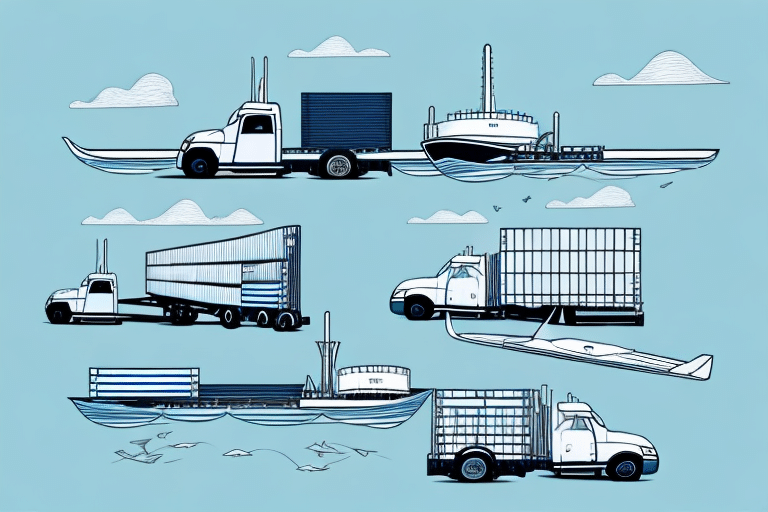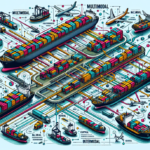Unlocking the Benefits of Multimodal Shipping
In today's global economy, businesses face the challenge of shipping their products to customers across borders and continents. Traditional shipping methods often involve multiple carriers and transportation modes, resulting in higher costs, longer lead times, and increased risk of lost or damaged shipments. Multimodal shipping offers companies a more efficient and cost-effective approach to logistics. This article explores the concept of multimodal shipping, its advantages over traditional methods, best practices, case studies, and future trends in the industry.
Understanding Multimodal Shipping
Multimodal shipping refers to the practice of combining different modes of transportation—such as air, sea, rail, and road—to move goods from one location to another. This approach involves coordinating the logistics of multiple carriers through a single operator or transportation intermediary, creating a seamless and integrated transportation network that can handle complex supply chains and optimize the flow of goods worldwide.
Key Advantages
- Flexibility and Efficiency: Multimodal shipping allows for greater flexibility in transportation, enabling companies to choose the most efficient and cost-effective routes. For example, transporting goods from a factory in China to a warehouse in the United States might involve a combination of air, sea, and road transportation to ensure timely and cost-effective delivery.
- Environmental Impact: By utilizing a combination of transportation modes, multimodal shipping can significantly reduce the overall carbon footprint. For instance, combining sea and rail transport is often more environmentally friendly than relying solely on road or air transport.
Multimodal Shipping vs. Traditional Methods
Compared to traditional shipping methods, multimodal shipping offers several distinct advantages that make it a superior choice for modern logistics.
Cost and Efficiency
Multimodal shipping enables businesses to optimize their shipping routes by selecting the best combination of transportation modes and carriers. This optimization can lead to reduced transportation costs and improved delivery times. According to the International Transport Forum, companies that adopt multimodal strategies can achieve cost savings of up to 15% compared to traditional methods.
Environmental Sustainability
By integrating various transportation modes, multimodal shipping helps in reducing carbon emissions. The International Civil Aviation Organization reports that shifting cargo from road to rail and sea can decrease emissions by approximately 30%.
Optimizing Your Supply Chain with Multimodal Shipping
Implementing a multimodal shipping strategy requires careful planning and adherence to best practices to optimize the supply chain effectively.
Best Practices
- Choose Reliable Intermediaries: Selecting a dependable transportation intermediary that can manage multiple carriers and modes is crucial for seamless logistics operations.
- Leverage Technology: Utilize GPS tracking, cloud-based logistics platforms, and real-time data analytics to monitor and manage shipments efficiently.
- Collaborate with Partners: Work closely with carriers and shippers to ensure smooth handovers and minimize delays.
- Consolidate Shipments: Consolidating shipments can reduce costs and improve overall efficiency.
Environmental Considerations
Evaluating the environmental impact of transportation choices is essential. Opting for more sustainable modes, such as rail or sea freight, can help reduce the carbon footprint and contribute to a greener supply chain.
Technology in Multimodal Shipping
Advancements in technology play a pivotal role in enhancing the efficiency and effectiveness of multimodal shipping.
Real-Time Tracking and Visibility
- GPS Tracking: Enables real-time monitoring of shipments, providing visibility into the location and status of goods.
- RFID and Barcodes: Facilitate automated data capture, improving accuracy and reducing the risk of human error.
Emerging Technologies
Innovations such as autonomous vehicles and drones are set to revolutionize the shipping industry. Autonomous vehicles can operate continuously, reducing delivery times, while drones can handle last-mile deliveries in hard-to-reach areas, enhancing overall efficiency.
Sustainability in Multimodal Shipping
Multimodal shipping offers significant environmental benefits, contributing to sustainability and compliance with regulations.
Reducing Carbon Emissions
Optimizing transportation modes and routes helps in minimizing carbon emissions. The Environmental Protection Agency highlights that strategic multimodal shipping can reduce emissions by up to 20% compared to traditional shipping methods.
Compliance with Regulations
Multimodal shipping assists companies in adhering to sustainability regulations, such as the IMO 2020 sulfur cap, which limits sulfur emissions from ships. Additionally, the adoption of electric and hybrid vehicles further enhances sustainability performance.
Case Studies: Success with Multimodal Shipping
Several companies have successfully implemented multimodal shipping strategies, resulting in improved logistics performance and cost savings.
DHL Global Forwarding
DHL helped a Brazilian pharmaceutical company reduce transportation costs by 20% while increasing delivery efficiency by 50% through a tailored multimodal shipping strategy.
Maersk Line
Maersk Line, the world's largest container shipping company, implemented a multimodal approach that successfully reduced its carbon footprint by 10%, aligning with its sustainability goals.
Honda Motor Company
Honda utilizes multimodal shipping to optimize its supply chain, achieving a 27% reduction in logistics costs. This strategy has enhanced its operational efficiency and reliability.
Future Trends in Multimodal Shipping
The multimodal shipping industry is poised for significant growth and innovation, driven by emerging trends and technological advancements.
Blockchain Technology
Blockchain offers enhanced transparency and security in the logistics process, enabling more efficient and secure transactions between parties.
Expansion of E-Commerce
The growth of cross-border e-commerce is increasing the demand for efficient and reliable logistics solutions, further driving the adoption of multimodal shipping.
Sustainability Initiatives
Continued focus on reducing environmental impact will drive the adoption of more sustainable transportation modes and practices within multimodal shipping.
Conclusion
Multimodal shipping provides businesses with a more efficient and cost-effective approach to logistics, enabling the optimization of supply chains, reduction of transportation costs, and improvement of environmental sustainability. By integrating various transportation modes and leveraging advanced technologies, companies can unlock the full benefits of multimodal shipping, gaining a competitive edge in the global marketplace. As the industry continues to evolve, innovations and sustainability efforts will further enhance the potential of multimodal shipping.




















